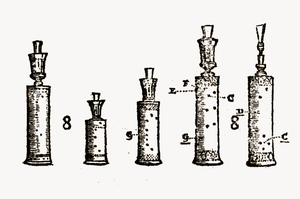Rackett

The rackett is a Renaissance-era double reed wind instrument.
There are several sizes of rackett, in a family ranging from soprano to great bass. Relative to their pitch, racketts are quite small (the tenor rackett is only 4½ inches long, yet its lowest note is F, two octaves below middle C). This is achieved through its ingenious construction. The body consists of a wooden chamber into which nine parallel cylinders are drilled. These are connected alternately at the top and bottom, resulting in a long wind passage within a compact body.
However, its unusual construction presents some problems for the player. Because of the unusual arrangement of the bores, the fingering pattern is somewhat unusual.
The baroque rackett (developed by the Nuremberg maker J. C. Denner, 1655–1707) had an entirely rationalized simpler fingering due in part to the addition of a number of tetines, which are tubular metal extensions covered by the middle joint of the index fingers as well as the pinkies during playing. It cannot be tuned by altering its length. While some say moisture buildup may become a problem, condensation usually remains in the coil of the removable brass crook, thus being fairly simple to expel during pauses. Despite its idiosyncrasies, the baroque rackett is a versatile instrument with a wide range of notes and tones. With an appropriate reed, the baroque rackett has a similar chromatic range to the baroque bassoon (BBb to g'), and with its agility, can perform any bass-instrument repertoire from the time in which it was in vogue.
Origin

The inventor of the rackett is unknown. The first historical mention can be found in German sources Wurttemberg inventories of 1576 (listed as a Raggett) and the Graz inventory of 1590 (listed as a Rogetten).[1] Early paintings of the Munich Court band and a carved cabinet by Christof Angermair depict a single rackett being played in a mixed consort of other instruments. Prior to the late seventeenth century, the rackett had a cylindrical bore and was blown through a pirouette. The more modern baroque rackett had an expanding conical bore and was blown through a coiled crook inserted into the side or top of the instrument. In some pictures, a large bell is attached to presumably enhance the tone.
Sound
Praetorius has noted "In sound [Renaissance] racketts are quite soft, almost as if one were blowing through a comb. They have no particular grace when a whole set of them is used together, but when violas da gamba are used with them, or when a single rackett is used together with other wind or stringed instruments and a harpsichord or the like, and is played by a good musician, it is indeed a lovely instrument. It is particularly pleasing and fine to hear on bass parts."[2]
The baroque rackett, sometimes called a "pocket bassoon", conversely, sounds much like a dulcian or baroque bassoon, and can easily blend with the same kind of ensemble instruments—violas da gamba, cornetti, historical keyboards, baroque recorders and small baroque orchestras.
References
External links
 Schlesinger, Kathleen (1911). "Rackett". In Chisholm, Hugh. Encyclopædia Britannica 22 (11th ed.). Cambridge University Press. p. 780.
Schlesinger, Kathleen (1911). "Rackett". In Chisholm, Hugh. Encyclopædia Britannica 22 (11th ed.). Cambridge University Press. p. 780.
| ||||||||||||||||||||||||||||||